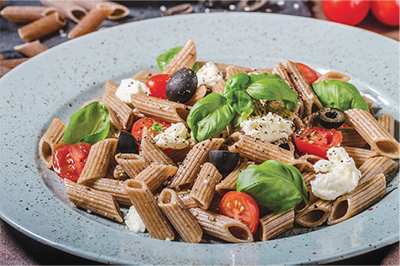
The grain group includes foods such as bread, tortillas, rice, pasta, and breakfast cereals made from wheat, rice, oats, cornmeal, barley, or other grains. Foods from this group provide B vitamins (thiamine, riboflavin, niacin, and folate), minerals (iron), and fiber.
Grains are divided into two subgroups: whole grains and refined grains. Whole grains contain the entire grain kernel—bran, germ, and endosperm. In refined grains, the germ and bran have been removed, which also removes the fiber, iron, and B vitamins. Refined grains replace the B vitamins and minerals in a process called “enriching.” It is usually impossible to recover fiber. For these reasons, you should eat whole grains instead of refined grains.
Consuming whole grains as part of a healthy diet may help lower the risk of heart disease and type 2 diabetes as well as contribute to enhanced weight management.

© Peteer | Dreamstime.com
The following nutrients are found in most grains. A typical American diet is at risk for being low in nutrients marked with an asterisk (*).
B vitamins release energy within the body, play an important role in metabolism, and help the nervous system work properly. Many refined grains are enriched with B vitamins.
*Fiber helps reduce blood cholesterol levels, may reduce the risk of heart disease, and promotes proper bowel function, including reducing constipation. Fiber-containing foods such as grains help provide a feeling of fullness with fewer calories.
*Folate helps produce red blood cells and reduces a woman’s risk of having a child with a brain or spinal cord defect.
*Iron is a mineral that carries oxygen in the blood to the body’s cells and helps protect against infections. Iron deficiency often leads to anemia, which causes you to feel tired and weak. Many women develop iron-deficiency anemia during their childbearing years and may need more meat and beans in their diet. To help reduce anemia, many foods are enriched or fortified with iron; breakfast cereals and flour are two examples.
Magnesium builds strong bones and helps muscles release energy.
Selenium is part of an antioxidant system and helps keep the immune system healthy.
MyPlate recommends eating between 3 and 8 ounces of grains every day, depending on your age, gender, and level of physical activity (Table 1). At least half of the servings should be from whole grains. For more information, visit www.choosemyplate.gov
MyPlate uses the term “ounce equivalent” when suggesting amounts of grain foods to consume.
What does a one-ounce equivalent from the grain group mean?
Table 1. Daily Recommendations for the Grain Group
Age
Ounces(s)
2–3 years
4–8 years